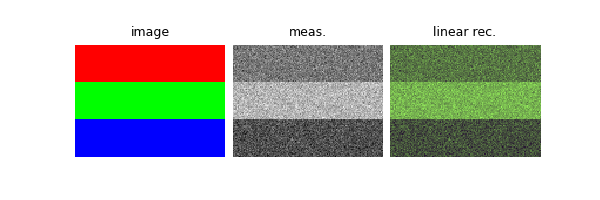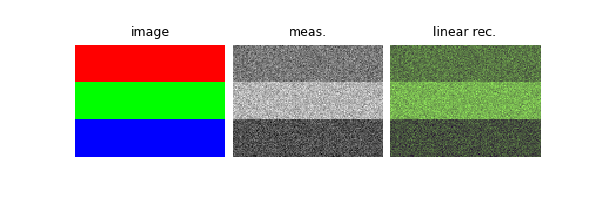Note
Go to the end to download the full example code.
Creating a forward operator.#
While deepinv offers a large number of forward operators in the physics module, you might want to create your own forward operator for your specific imaging problem. This example walks you through the creation of a custom forward operator.
We will create a simple forward operator that converts RGB images to grayscale images by averaging the color channels. We also show you how to exploit the singular value decomposition of the operator to speed up the evaluation of the pseudo-inverse and proximal operators.
import deepinv as dinv
import torch
Creating a custom forward operator.#
Defining a new linear operator only requires a forward function and its transpose operation,
inheriting the remaining structure of the deepinv.physics.LinearPhysics class.
Once the operator is defined, we can use any of the functions in the deepinv.physics.Physics class and
deepinv.physics.LinearPhysics class, such as computing the norm of the operator, testing the adjointness,
computing the proximal operator, etc.
# define an operator that converts color images into grayscale ones.
class Decolorize(dinv.physics.LinearPhysics):
r"""
Converts RGB images to grayscale.
Signals must be tensors with 3 colour (RGB) channels, i.e. [*,3,*,*]
The measurements are grayscale images.
"""
def __init__(self, **kwargs):
super().__init__(**kwargs)
self.noise_model = dinv.physics.GaussianNoise(sigma=0.1)
# the RGB to grayscale coefficients
coefficients = torch.tensor([0.2989, 0.5870, 0.1140], dtype=torch.float32)
# register the coefficients as a buffer
self.register_buffer("coefficients", coefficients)
def A(self, x, theta=None): # theta is an optional parameter that is not used here
y = (
x * self.coefficients[None, :, None, None]
) # apply coefficients to each channel
return torch.sum(y, dim=1, keepdim=True) # sum over the color channels
physics = Decolorize(img_size=(3, 96, 128))
Generate toy image#
This example uses a toy image with 3 color channels.
x = torch.zeros(1, 3, 96, 128)
x[:, 0, :32, :] = 1
x[:, 1, 32:64, :] = 1
x[:, 2, 64:, :] = 1
y = physics(x)
xlin = physics.A_dagger(y) # compute the linear pseudo-inverse
dinv.utils.plot([x, y, xlin], titles=["image", "meas.", "linear rec."])
print(f"The linear operator has norm={physics.compute_norm(x):.2f}")

Power iteration converged at iteration 2, value=0.45
The linear operator has norm=0.45
Implementing a closed form adjoint#
If we know the closed form of the adjoint operator, we can implement it directly in the
deepinv.physics.LinearPhysics.A_adjoint() method. By default, the adjoint is computed using
autodifferentiation (see deepinv.physics.adjoint_function()), but this comes at a potential cost of
additional memory and computation time.
An additional benefit of implementing the adjoint is that we won’t require the img_size parameter when creating the operator, which is required for the autodifferentiation to work.
If you implement your own adjoint, it is recommended to verify that the transpose well-defined using
deepinv.physics.LinearPhysics.adjointness_test().
class Decolorize(dinv.physics.LinearPhysics):
r"""
Converts RGB images to grayscale.
Signals must be tensors with 3 colour (RGB) channels, i.e. [*,3,*,*]
The measurements are grayscale images.
"""
def __init__(self, **kwargs):
super().__init__(**kwargs)
self.noise_model = dinv.physics.GaussianNoise(sigma=0.1)
# the RGB to grayscale coefficients
coefficients = torch.tensor([0.2989, 0.5870, 0.1140], dtype=torch.float32)
# register the coefficients as a buffer
self.register_buffer("coefficients", coefficients)
def A(self, x, theta=None): # theta is an optional parameter that is not used here
y = (
x * self.coefficients[None, :, None, None]
) # apply coefficients to each channel
return torch.sum(y, dim=1, keepdim=True) # sum over the color channels
def A_adjoint(self, y, theta=None):
return y * self.coefficients[None, :, None, None]
physics = Decolorize()
if physics.adjointness_test(x) < 1e-5:
print("The linear operator has a well defined transpose")
The linear operator has a well defined transpose
Creating a decomposable forward operator.#
If the forward operator has a closed form singular value decomposition (SVD),
it is recommended to implement the operator using the deepinv.physics.DecomposablePhysics method.
The operator in this example is decomposable, so we can implement it using
deepinv.physics.DecomposablePhysics.
Tip
As in the case of LinearPhysics, V and U_adjoint are implemented using autodifferentiation by default, but you can implement them directly if you know the closed form of the operator.
class DecolorizeSVD(dinv.physics.DecomposablePhysics):
r"""
Converts RGB images to grayscale.
Signals must be tensors with 3 colour (RGB) channels, i.e. [*,3,*,*]
The measurements are grayscale images.
"""
def __init__(self, **kwargs):
super().__init__(mask=0.447, **kwargs)
self.noise_model = dinv.physics.GaussianNoise(sigma=0.1)
# the RGB to grayscale coefficients
coefficients = torch.tensor([0.6687, 1.3132, 0.2550], dtype=torch.float32)
# register the coefficients as a buffer
self.register_buffer("coefficients", coefficients)
def V_adjoint(self, x):
y = x * self.coefficients[None, :, None, None]
return torch.sum(y, dim=1, keepdim=True)
def V(self, y):
return y * self.coefficients[None, :, None, None]
physics2 = DecolorizeSVD()
y2 = physics2(x)
xlin2 = physics.A_dagger(y2) # compute the linear pseudo-inverse
dinv.utils.plot([x, y2, xlin2], titles=["image", "meas.", "linear rec."])
print(f"The decomposable operator has norm={physics.compute_norm(x):.2f}")
if physics.adjointness_test(x) < 1e-5:
print("The decomposable operator has a well defined transpose")

Power iteration converged at iteration 2, value=0.45
The decomposable operator has norm=0.45
The decomposable operator has a well defined transpose
Benefits of using a decomposable forward operator.#
If the forward operator has a closed form singular value decomposition (SVD),
it is recommended to implement the operator using deepinv.physics.DecomposablePhysics.
The operator in this example is decomposable, so we can implement it using
deepinv.physics.DecomposablePhysics.
The main benefit of using a decomposable forward operator is that it provides closed form solutions for the
proximal operator and the linear pseudo-inverse. Moreover, some algorithms, such as deepinv.sampling.DDRM
require the forward operator to be decomposable.
import time
start = time.time()
for i in range(10):
xlin = physics.A_dagger(y)
xprox = physics.prox_l2(x, y, 0.1)
end = time.time()
print(f"Elapsed time for LinearPhysics: {end - start:.2f} seconds")
start = time.time()
for i in range(10):
xlin2 = physics2.A_dagger(y)
xprox2 = physics2.prox_l2(x, y2, 0.1)
end = time.time()
print(f"Elapsed time for DecomposablePhysics: {end - start:.2e} seconds")
Elapsed time for LinearPhysics: 0.01 seconds
Elapsed time for DecomposablePhysics: 1.99e-03 seconds
Total running time of the script: (0 minutes 0.120 seconds)

